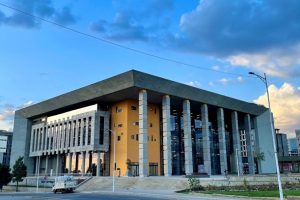Tourism is a social, cultural and economic phenomenon which involves movement of people to countries or places out from their usual environment. The purpose of their movement might be personal or business. These people can be tourists, excursionists, residents or non residents, known as visitors.
And tourism have to do with their activities they produce. Some of the activities they involve in imply tourism expenditure, for example, accommodation they use or food. In their travel, accommodation provides the base, from which tourists can engage in any activities at a destination, therefore, travelling will be incomplete in absence of accommodation, according to scholars like Gilbert and Wanhill.
Accommodation or lodging is, by a long way, the largest and most ubiquitous sub-sector within the tourism economy. With few exceptions, tourists require a location where they can rest and revive during their travel through, or stay within a tourism destination. As a customer-centric airline, Ethiopian Airlines always seeks to offer its passengers end-to-end travel experience through continued service excellence.
As part of this effort, Ethiopian Airlines recently inaugurated its five-star Ethiopian Skylight Hotel, three years after its launch in January 2016, which is located within a stone’s throw from Addis Ababa Bole International Airport. The 65 million USD worth hotel is a significant addition to conference facilities of the fast growing capital of Africa, offering hospitality at par with the international standard. It is managed at international standard by Grand Skylight Hotel Management Co. Ltd/GSHM.
Ethiopian Skylight Hotel, creating more than 800 jobs, with 373 rooms and multiple facilities sitting on 40,000sqm, is the biggest such facility in Ethiopia. The guest rooms include deluxe executive suites and executive suites in addition to the standard single and double bed rooms. It encompasses four restaurants including a big Chinese Restaurant, swimming pools, gift shops, pastries, big banquet hall which accommodates 2000 guests at a time, five small size meeting rooms, gym, health center and ticket office, among others. Seeing that the running capital Addis Ababa is on the upswing as the world’s gateway into Africa with a massive influx of global passengers, the cutting edge facility will help catalyze the inbound and outbound mobility.
As well, it will enhance the travel experiences of customers transiting via Addis Ababa Airport and tourists who come to Ethiopia through the travel packages. These packages include Ethiopian UNESCO Registered Tangible and Intangible Heritages, such as Lalibela, Fascilidas, Endemic Animal Parks, Meskel Festival, Irreecha Festival, Ethiopian Epiphany and Fiche Chambalala.
Therefore it is the tour operator wing of Ethiopian Airlines. In other words, it will undoubtedly contribute its share to the growth of Ethiopia’s tourism by creating favorable environment for travelers’ stay in Ethiopia. Besides, since the city has a growing demand for international standard lodging, hotels and recreational centers with corresponding conference tourism growth, it will serve as an addition to the hospitality industry.
Furthermore, Ethiopian Airlines is also finalizing preparations to commence the 2nd phase of Ethiopian Skylight Hotel which will bring the total guest room number to 1000 considering the profitability of the industry. Simultaneously, the Airline also inaugurated the massively expanded terminal at Bole International Airport, with almost thrice the capacity of the existing one setting the bar high in Africa’s airport industry.
As Ethiopian Airlines’ main hub, the airport has seen a steady increase in passenger volume over the years due to Addis Ababa’s unique location in the middle of East-West major trade lane. And it’s increasing significance in the diplomatic realm and conference tourism, and the seamless connectivity options Ethiopian Airlines offers at the hub for all travelers is essential. The airport is expanded with a view to relieve the congestion and enhance passengers’ ground-to-air experiences.
Though the existing airport terminal was initially designed to accommodate 6 million passengers annually, currently it is serving over 10 million passengers every year. The new terminal has a capacity to cater to 22 million passengers annually, in addition to upgraded runways and navigations systems.
The expansion included additional 86,000m2 of floor area of space for terminal 2, around 16,000 m2 for terminal 1 and around 6000 m2 for the new VIP terminal. China Communication Construction Company (CCCC) is in charge of the expansion project with 225 million USD and 138 million USD for Terminals 2 and 1 with New VIP Terminal respectively.
Moreover, with its new dutyfree shops, restaurants, auto-walks, escalators, panoramic lifts and many other accommodations, the new facility will take travelers’ experience to a whole new level. Similarly, it has a new check-in hall with an elevated motorway, more international gates as well as checkin and immigration counters. What is more is that the Airline has a vision to automate and facilitate the check-in process the terminal features hi-tech airport systems such as automated bag drop solutions, e-gates, self-checkin kiosks, and baggage handling and tilting tray sorter systems.
The ultra-modern facility will improve safety and optimize efficiency with its integrated systems and solutions that add flexibility and control to the operations. The airport facility is developed not only to accommodate the current traffic growth at the airport, but in due consideration of the growth indicators of the continent including traffic growth forecast and the rising middle class. These all investments prove that Ethiopia is building a new face of hospitality industry.
Herald February 1/2019
BY DIRRIBA TESHOME





